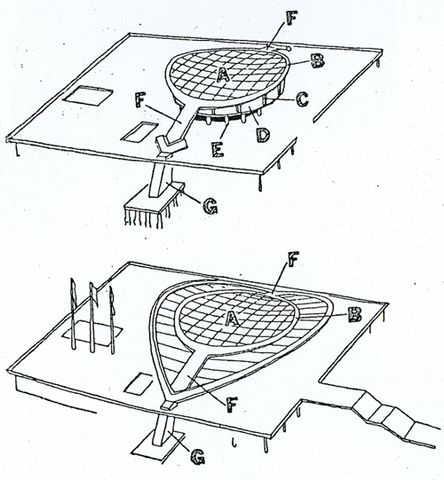1960: The Roof: Its Symbol and Function
The Congress Hall debate and Frei Otto’s criticisms

Routine sets in at the Congress Hall. The German doctors hold their congress there, as do the metalworkers’ union, road researchers, “film-workers for the youth”, the German student union, the German writers' union, the Union des Etudiants Catholiques Africains and the Liberale Weltunion (later the Liberale Internationale). Normality prevails – if indeed one may speak of normality in a city in which more than 150,000 people will cross the demarcation line from East to West this year alone. At a time when thousands and thousands of people a year are leaving their homes between Rügen and the Erzgebirge and using Berlin as an emergency exit, the returnees hold their congress at the Congress Hall. German history is evidently keeping people on the move ...
The fact that the Congress Hall has thus become a beacon of freedom is not lost on the East, as the petulant tone of an article published in the East German architectural journal in March clearly shows. A few years later, the East German magazine Deutsche Architecture will recapitulate the arguments advanced by the West German architect Frei Otto, probably the shrewdest critic of the Congress Hall’s design. Nor will it forgo the obligatory polemic against Eleanor Dulles, accused in the introduction of regularly infiltrating agents and arsonists. For all that, it is worth revisiting the debate between Otto and Hugh Stubbins. (Otto experimented with tent structures in the 1950s and later designed bold space grid structures such as the Olympic Stadium in Munich.)
In 1958, the respective arguments of Otto and Stubbins appear simultaneously in the German architectural magazine Bauwelt and in the American Architectural Forum The very different and perhaps prototypical approaches of the two architects are quite apparent. Frei Otto’s main criticism is directed at the roof structure, which he deems too complicated. Everything is borne ultimately by the concrete ring (above the auditorium), whose load is transferred only to a minor degree down through the two pillars. The point is that this concrete ring and other load-bearing elements, which would be unnecessary in a different type of structure, are hidden from view. The design does not strive for a unity of form and function, complains Otto. Stubbins replies that form, which is dependent on function, must be subordinated to the goal of expressing beauty. Whereas Otto declares that it is absurd to search for (and construct) the form of an abstract idea, the US architect argues that human beings have a fundamental need for symbols. Here, the East German magazine Deutsche Architektur certainly quotes Stubbins correctly, even if it does end up suppressing his arguments. And Frei Otto sums up by pointing out that this new building form is unquestionably "a significant act" - a necessary beginning. Unsurprisingly, though, the East German magazine closes on a totally negative note: for all the impressive talk about democracy and the “free spirit”, such talk is just as hypocritical as the entire concept of the West Berlin Congress Hall. Q.E.D. …
Axel Besteher-Hegenbart
Helgard Behrendt, Die Mauerschneise, Berlin 1994
Deutsche Architektur, 3/1960
Architectural Forum 108, 1958
Bauwelt 1/1958